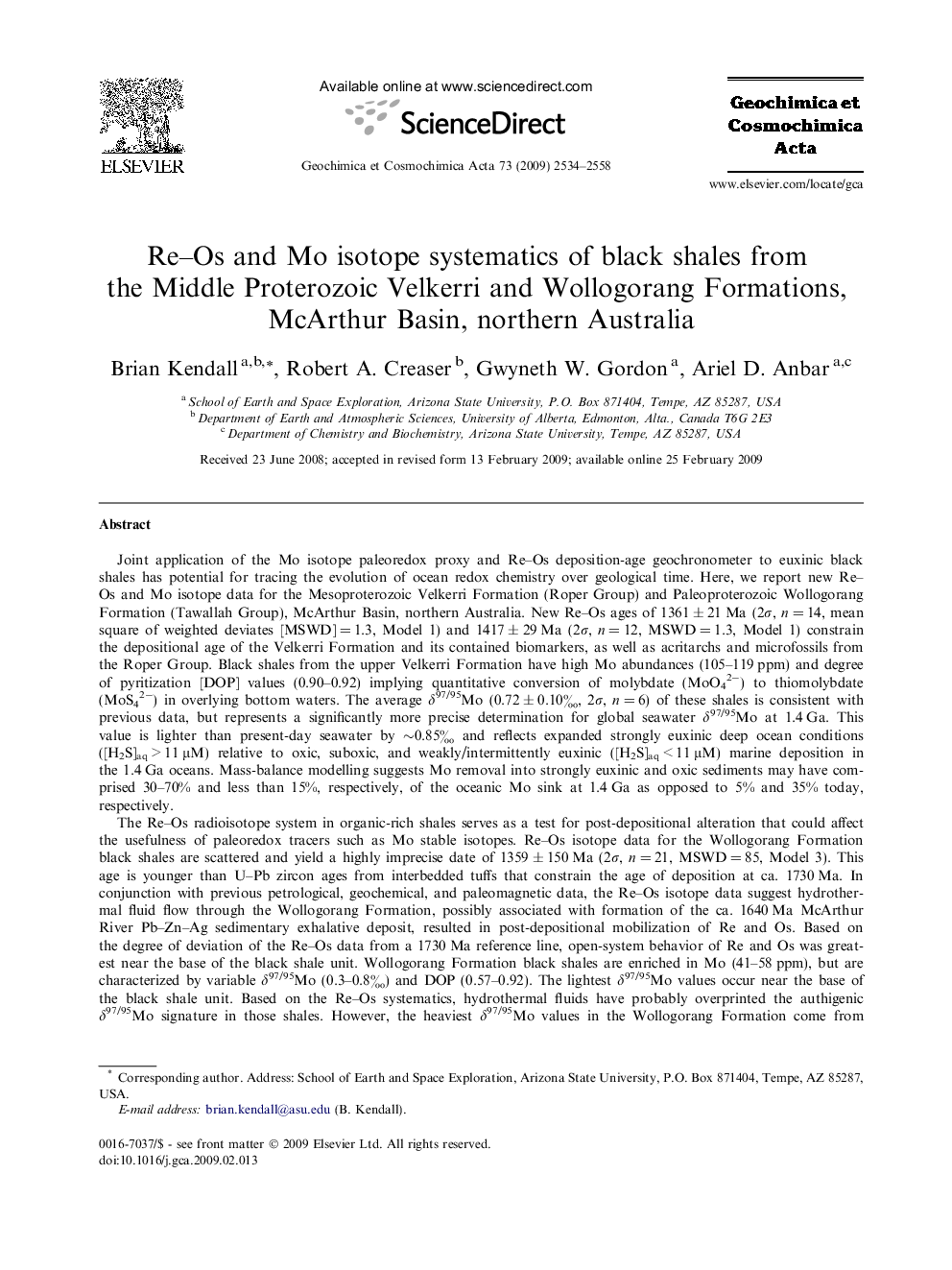| کد مقاله | کد نشریه | سال انتشار | مقاله انگلیسی | نسخه تمام متن |
|---|---|---|---|---|
| 4705069 | 1352941 | 2009 | 25 صفحه PDF | دانلود رایگان |

Joint application of the Mo isotope paleoredox proxy and Re–Os deposition-age geochronometer to euxinic black shales has potential for tracing the evolution of ocean redox chemistry over geological time. Here, we report new Re–Os and Mo isotope data for the Mesoproterozoic Velkerri Formation (Roper Group) and Paleoproterozoic Wollogorang Formation (Tawallah Group), McArthur Basin, northern Australia. New Re–Os ages of 1361 ± 21 Ma (2σ, n = 14, mean square of weighted deviates [MSWD] = 1.3, Model 1) and 1417 ± 29 Ma (2σ, n = 12, MSWD = 1.3, Model 1) constrain the depositional age of the Velkerri Formation and its contained biomarkers, as well as acritarchs and microfossils from the Roper Group. Black shales from the upper Velkerri Formation have high Mo abundances (105–119 ppm) and degree of pyritization [DOP] values (0.90–0.92) implying quantitative conversion of molybdate (MoO42−) to thiomolybdate (MoS42−) in overlying bottom waters. The average δ97/95Mo (0.72 ± 0.10‰, 2σ, n = 6) of these shales is consistent with previous data, but represents a significantly more precise determination for global seawater δ97/95Mo at 1.4 Ga. This value is lighter than present-day seawater by ∼0.85‰ and reflects expanded strongly euxinic deep ocean conditions ([H2S]aq > 11 μM) relative to oxic, suboxic, and weakly/intermittently euxinic ([H2S]aq < 11 μM) marine deposition in the 1.4 Ga oceans. Mass-balance modelling suggests Mo removal into strongly euxinic and oxic sediments may have comprised 30–70% and less than 15%, respectively, of the oceanic Mo sink at 1.4 Ga as opposed to 5% and 35% today, respectively.The Re–Os radioisotope system in organic-rich shales serves as a test for post-depositional alteration that could affect the usefulness of paleoredox tracers such as Mo stable isotopes. Re–Os isotope data for the Wollogorang Formation black shales are scattered and yield a highly imprecise date of 1359 ± 150 Ma (2σ, n = 21, MSWD = 85, Model 3). This age is younger than U–Pb zircon ages from interbedded tuffs that constrain the age of deposition at ca. 1730 Ma. In conjunction with previous petrological, geochemical, and paleomagnetic data, the Re–Os isotope data suggest hydrothermal fluid flow through the Wollogorang Formation, possibly associated with formation of the ca. 1640 Ma McArthur River Pb–Zn–Ag sedimentary exhalative deposit, resulted in post-depositional mobilization of Re and Os. Based on the degree of deviation of the Re–Os data from a 1730 Ma reference line, open-system behavior of Re and Os was greatest near the base of the black shale unit. Wollogorang Formation black shales are enriched in Mo (41–58 ppm), but are characterized by variable δ97/95Mo (0.3–0.8‰) and DOP (0.57–0.92). The lightest δ97/95Mo values occur near the base of the black shale unit. Based on the Re–Os systematics, hydrothermal fluids have probably overprinted the authigenic δ97/95Mo signature in those shales. However, the heaviest δ97/95Mo values in the Wollogorang Formation come from stratigraphically higher shales, and are similar to those observed for the Velkerri Formation, and thus may reflect seawater δ97/95Mo at 1.73 Ga.
Journal: Geochimica et Cosmochimica Acta - Volume 73, Issue 9, 1 May 2009, Pages 2534–2558